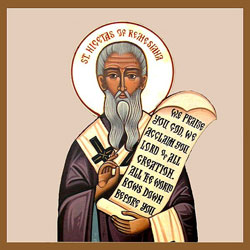
Feastday: June 22Nicetas became bishop of his native city of Remesiana (Bela Palenka, Serbia). He was a close friend of Saint Paulinus of Nola, who praises him as a virtuous and learned bishop, gifted with a pure and priestly heart and with a clear-thinking mind. Paulinus also pays tribute to Nicetas' missionary labors across the Balkan Peninsula. Nicetas is now known mainly through his writings. In one of his works, The Vigils of the Saints, he encourages the practice of keeping a watch of prayer in the night. He cites the numerous direct or indirect references to this form of prayer in the New Testament, and invokes the examples of the saints. He also explains the advantages of this practice: "The quiet and solitude of the night make it a favorable time for prayer and most suitable for those who watch. With worldly occupations put aside and the attention undivided, the whole man, at night, stands in the divine presence." Nicetas also delivered a sermon on the importance of liturgical singing. In fact, he is believed to be the author of the Church's perennial hymn of thanksgiving, the Te Deum.
Birth: 335
Death: 414
Nicetas (c. 335–414) was Bishop of Remesiana, (present-day Bela Palanka, Serbia), which was then in the Roman province of Dacia Mediterranea.
Biography
Nicetas promoted Latin sacred music for use during the Eucharistic worship and reputedly composed a number of liturgical hymns, among which some twentieth-century scholars number the major Latin Christian hymn of praise, Te Deum, traditionally attributed to Ambrose and Augustine. He is presumed to be the missionary to the barbarian Thracian tribe of the Bessi.
Because of his missionary activity, his contemporary and friend, Paulinus of Nola, lauded him poetically for instructing in the Gospel barbarians changed by him from wolves to sheep and brought into the fold of peace, and for teaching to sing of Christ with Roman heart bandits, who previously had no such ability. However, it is doubtful whether these barbarians really were barbarians, or whether their mention is only a poetical topos. Indeed, Paulinus, who wrote a quite classical Latin poetry, probably used existing poetical authorities. For Dacia, where Nicetas was from, the poetical authority was Ovid, although the Dacia (probably the province Dacia Mediterranea) of that time did not correspond with the Getia where Ovid had been banished to.
In 398, Nicetas made a pilgrimage to Nola to visit the grave of Felix of Nola.
Lengthy excerpts survive of his principal doctrinal work, Instructions for Candidates for Baptism, in six books. They show that he stressed the orthodox position in trinitarian doctrine. They contain the expression "communion of saints" about the belief in a mystical bond uniting both the living and the dead in a certain hope and love. No evidence survives of previous use of this expression, which has since played a central role in formulations of the Christian creed.
His feast day as a saint is on 22 June.





